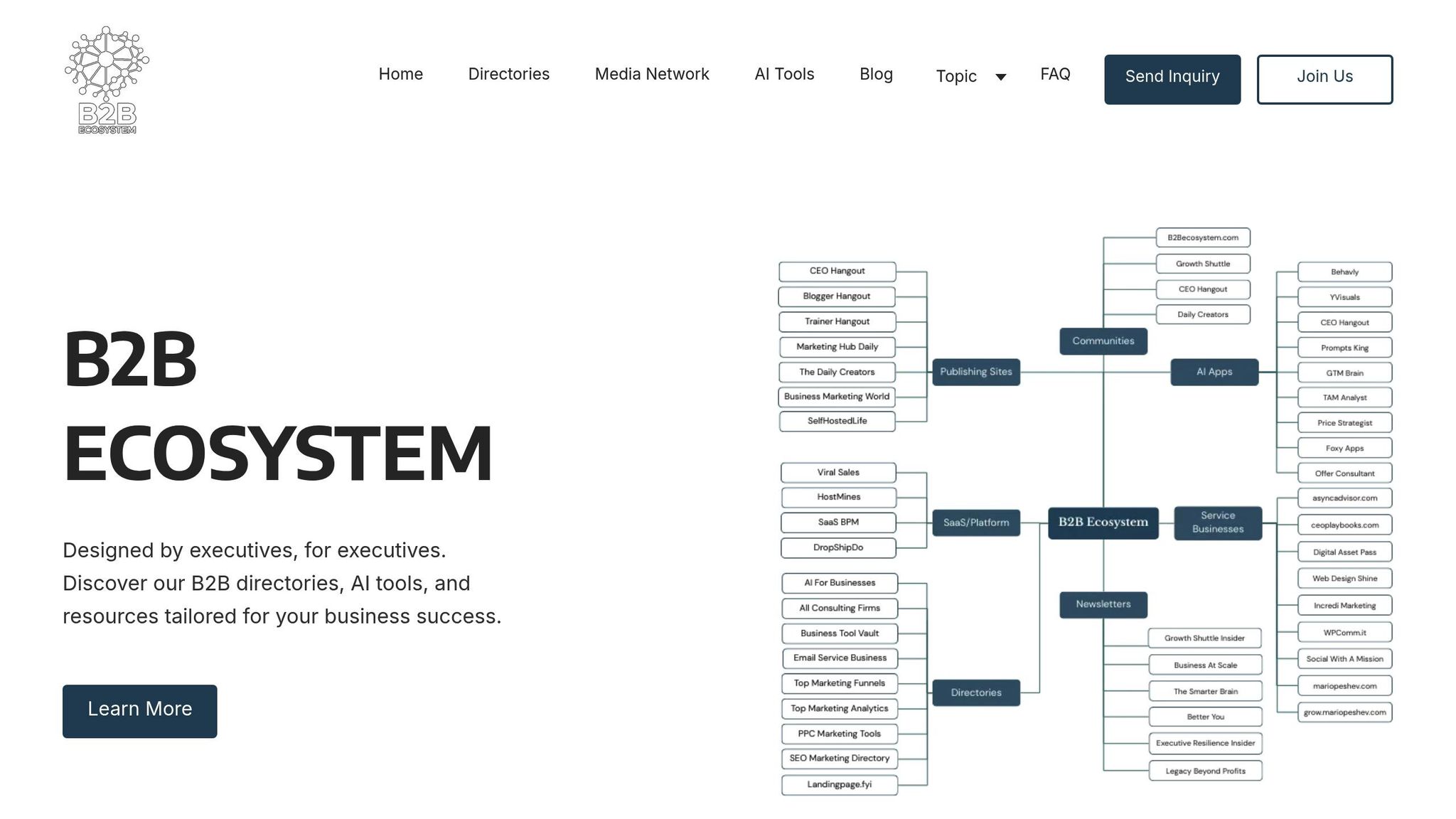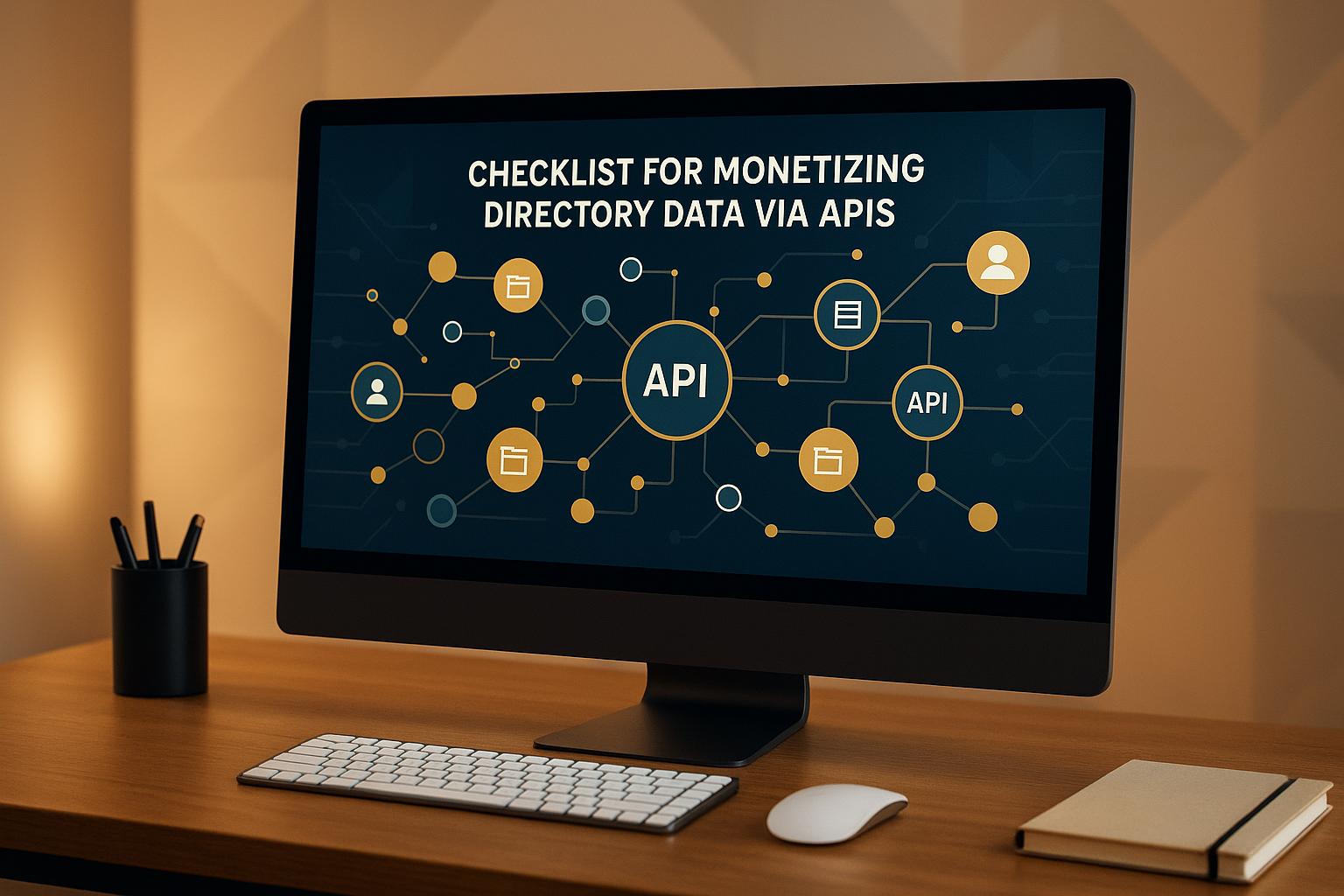Public-private innovation hubs are reshaping how businesses grow by connecting government resources, private expertise, academic research, and startups. These hubs create spaces where ideas turn into products and companies access new markets. Here's what makes them effective:
- Collaboration: Governments provide infrastructure and policies, private firms offer funding and market knowledge, universities contribute research and talent, and startups bring agility.
- Economic Impact: Hubs contribute to 60% of U.S. exports, employ 80% of engineers, and account for most patents, with workers earning higher wages.
- Models: Regional innovation districts, industry-led hubs, and university clusters each focus on specific goals, from urban development to sector-specific challenges.
- Market Access: Hubs help businesses navigate regulations, secure funding, and connect with customers and investors, both locally and globally.
- Success Stories: Examples like Cortex in St. Louis and Research Triangle Park in North Carolina show how hubs drive investment, jobs, and innovation.
For businesses, joining these hubs means faster market entry, access to advanced resources, and increased visibility. With proper collaboration and strategic involvement, these hubs offer a clear path to growth.
GEC 2025: The Public-Private Partnership Playbook for Startup Success + Economic Growth
Common Partnership Models for Market Expansion
Public-private innovation hubs use several partnership models to help businesses grow and enter new markets. By understanding these models - regional districts, industry-led hubs, and university clusters - companies can identify effective ways to expand their reach.
Regional Innovation Districts
Regional innovation districts bring together key institutions and businesses in urban areas, creating a collaborative environment. These districts make it easier for companies to connect with regional players and access both domestic and global markets.
The Global Institute on Innovation Districts highlights 35 districts that follow the "anchor-plus" model, which accounts for more than three-quarters of all districts in their Global Network. These districts attract both talent and businesses with their strategic locations and infrastructure.
"Innovation districts are primarily found in midtown and downtown areas." - The Global Institute on Innovation Districts
A great example of this model is Kendall Square in Cambridge, Massachusetts. Positioned near MIT and connected to Harvard and Mass General, it has grown into a major innovation hub, attracting startups and large tech firms alike. Its success stems from strong university-industry partnerships that fuel innovation.
Another example is the Cortex Innovation Community in St. Louis, Missouri. Established in 2002, Cortex transformed a 200-acre area into a thriving research and business hub. By pooling local funds, philanthropic donations, and public incentives, it built on St. Louis's strengths in plant and life sciences research, connecting institutions like St. Louis University, Washington University Medical School, and Barnes Jewish Hospital.
Industry-Led Open Innovation Hubs
Unlike regional districts, industry-led hubs focus on solving sector-specific challenges. These hubs are created by companies or industry groups to drive innovation in their fields, forming networks that connect businesses with industry leaders for growth opportunities.
Studies show that most companies involved in open innovation hubs report faster innovation, a more adaptable workforce, and financial gains.
Dhahran Techno Valley (DTVC) in Saudi Arabia showcases this model's potential. Located at King Fahd University of Petroleum and Minerals, DTVC focuses on energy and sustainability research. It brings together academic expertise, local giants like Saudi Aramco and SABIC, and international firms such as Baker Hughes, creating a collaborative ecosystem for innovation.
"Open innovation is a paradigm that assumes that firms can and should use external ideas as well as internal ideas, and internal and external paths to market, as they look to advance their technology." - Henry Chesbrough, Professor at Harvard University
For these hubs to succeed, they need clear objectives and strong intellectual property and confidentiality agreements.
University-Led Innovation Clusters
University-led clusters combine academic research with business incubation to drive innovation and help companies enter new markets. These clusters offer startups access to cutting-edge research facilities, technical expertise, and commercialization support.
They often collaborate with government funding agencies and private investors, ensuring businesses have the resources needed to grow. Additionally, universities maintain global partnerships and exchange programs that open doors for international market entry. The academic validation provided by these collaborations can significantly enhance a company's reputation when expanding into new markets.
How Hubs Expand Market Access
Public–private innovation hubs act as bridges, helping businesses tap into new markets by offering key resources, building connections, and sharing expertise. These hubs serve as strategic partners for companies looking to expand their reach.
Connecting Businesses to New Markets
The first step for an effective hub is to map out the innovation ecosystem in its region. Take the Alliance for SoCal Innovation, for example. Established in 2017, it created a detailed map of Southern California's innovation landscape, encompassing corporations, startups, academic institutions, investors, service providers, and government agencies. This groundwork paved the way for major market expansion efforts. By 2022, the Alliance had engaged over 1,200 innovation leaders from more than 120 institutions, hosted a startup showcase featuring 24 companies and 230 industry representatives, and facilitated over 2,200 connections that helped 15 businesses secure $63 million in funding.
Mapping is just the beginning. Successful hubs take it further by fostering collaborations that link businesses directly to customers and investors.
The table below highlights how different innovation hubs approach market access:
| Market Access Mechanism | Alliance for SoCal Innovation | Research Triangle Park | Cortex (Market Access Contributions) |
|---|---|---|---|
| Stakeholder Mapping | Engaged 1,200+ innovation leaders across 120+ institutions | Encompasses 300 companies and 50,000+ employees from three academic institutions | Includes 400 companies, 85% of which are small businesses |
| Collaboration | Hosted First Look Showcase with 24 startups pitching to 230 representatives | Focuses on academic-industry partnerships | Offers coworking spaces, incubators, and accelerators |
| Funding Facilitation | Helped 15 companies raise $63 million in 2022 | Drives $6 billion in annual research spending by companies and universities | Generated $500 million in investments |
| Direct Networking | Facilitated 2,200+ introductions in 2022 | Backed by competitive state and local incentives | Provides tax abatements and incremental financing |
While these hubs excel at driving local market growth, they also play a pivotal role in helping businesses expand internationally through global connections.
Supporting International Market Entry
Innovation hubs don't just stop at local opportunities - they also help businesses break into global markets. They achieve this by leveraging international partnerships and creating open innovation programs that connect local companies with global prospects. This approach helps businesses, especially smaller ones, overcome the usual hurdles of international expansion.
"When talented people come together to solve big problems, great things can happen. The Maryland Innovation Lab will help us address pressing challenges by connecting companies in our state with companies around the world willing to share their expertise."
- Wes Moore, Governor of Maryland
These hubs bring together companies, agencies, talent, technology, and funding to drive innovation and create jobs worldwide. Governments are increasingly investing in these ecosystems to stay competitive in tech-heavy industries. A key factor in global success is the hub's ability to focus on specific industries or capabilities, enabling businesses to benefit from specialized expertise and well-established networks when entering foreign markets.
For instance, Research Triangle Park in North Carolina has built a robust innovation ecosystem anchored by Duke University, the University of North Carolina at Chapel Hill, and North Carolina State University. With 300 companies employing over 50,000 people, the hub has contributed to more than 3,000 patents and attracted international partnerships. Additionally, innovation hubs like this have shown faster commercial rent growth (5.3% from 2010 to 2020, compared to 4.8% in surrounding areas), signaling strong global demand for these locations. Coordinated talent strategies further strengthen international expansion by providing businesses access to the skilled workforce they need to compete on a global stage.
sbb-itb-01010c0
Benefits for B2B Companies
Innovation hubs don’t just connect businesses to markets; they offer direct advantages for B2B companies, helping them grow revenue and strengthen their market position. These hubs are more than just networking platforms - they deliver tangible results.
Faster Market Entry and Growth
One of the biggest perks of innovation hubs is how they speed up market entry. By tapping into pre-existing networks and established customer pathways, companies can bypass much of the trial-and-error phase that typically comes with entering new markets.
Take the Alliance for SoCal Innovation's SoCal Venture Pipeline as an example. This program streamlines the funding process, enabling startups to secure early-stage investments quickly. With such rapid access to funding, businesses can set up operations in new markets much faster than if they had to build connections from scratch.
Access to Advanced Technologies and Expertise
Public-private hubs also serve as springboards for technological advancement. By bringing together expertise from academia, government, and industry, these hubs give B2B companies access to high-level research and development capabilities that would otherwise be difficult - or prohibitively expensive - to achieve on their own.
For instance, the CHIPS and Science Act of 2022 allocated $10 billion over five years to establish the Regional Technology and Innovation Hubs program. This initiative aims to boost U.S. economic and national security by positioning regions as leaders in emerging technologies and industries.
"The Tech Hubs Program aims to strengthen U.S. economic and national security with investments in regions across the country with assets and resources with the potential to become globally competitive in the technologies and industries of the future - and for those industries, companies, and the good jobs they create, to start, grow, and remain in the United States."
Globally, similar efforts are underway. In 2023, the German government allocated €170 million to SPRIND, an agency focused on supporting breakthrough technology projects. Such funding creates shared R&D infrastructure, allowing companies to leverage cutting-edge capabilities without bearing the full cost of development.
Collaboration within these hubs also brings together diverse expertise. Academic partners contribute research insights, government agencies offer funding and regulatory support, and private sector players provide real-world industry knowledge. This collective approach not only accelerates technology adoption but also helps companies avoid common missteps, giving them a competitive edge in the market.
Better Visibility and Credibility
Being part of a reputable innovation hub can significantly boost a company’s credibility. Many hubs have rigorous vetting processes, which signal to potential partners and customers that the companies involved meet high standards. Additionally, the hub’s connections with major corporations, government bodies, and academic institutions lend credibility by association.
Participation in hub activities - such as showcases, networking events, and collaborative projects - further enhances visibility. Many hubs also form international partnerships, giving B2B companies exposure to global markets. This increased credibility not only accelerates market acceptance but also drives growth.
Role of The B2B Ecosystem

The B2B Ecosystem complements these benefits by making hub-driven opportunities even more accessible. It offers AI-powered go-to-market tools, strategic directories, and expert advisory services to enhance participation in innovation hubs.
Through its digital media network, The B2B Ecosystem amplifies the visibility that companies gain from hub involvement. Its publications and community platforms highlight hub-related achievements and partnerships, helping businesses expand their reach and strengthen their market presence.
Requirements and Best Practices for Participation
Joining a public-private innovation hub takes more than just a great idea. These partnerships come with specific requirements, and success often hinges on a strategic approach. By understanding the expectations and adopting best practices, businesses can turn these collaborations into powerful opportunities rather than missed chances.
Requirements for Participation
Innovation hubs typically operate through consortium-based models. This means individual companies can't apply independently - they must be part of a consortium that includes at least five eligible entities from different sectors. These might include universities, state or local government agencies, industry groups or firms in relevant technology fields, economic development organizations, and workforce training entities. This structure ensures a blend of public and private expertise to drive the hub's success.
For businesses, additional requirements often depend on the specific program. For example, in initiatives like the SBIR program, eligible small businesses must be for-profit, primarily U.S.-owned, and conduct all research and development within the United States, even if international subcontractors are involved.
Location also matters. The Economic Development Administration defines a hub's geographic scope as a Metropolitan Statistical Area or a similar region. These areas are chosen for their concentrated resources, including capital, R&D capabilities, skilled labor, and infrastructure that align with the hub's core technology focus. Businesses must demonstrate how their operations fit into these regional strengths and priorities.
Meeting these requirements is just the first step. To truly benefit, businesses must embrace a collaborative mindset.
Best Practices for Maximum Value
Thriving in an innovation hub means going beyond checking boxes. The most successful participants actively engage in building partnerships and fostering collaboration.
Forming meaningful cross-sector relationships is key. A great example of this is GM Defense's partnership with the Defense Innovation Unit. By applying commercial automobile battery technology to defense needs, they successfully bridged two very different sectors. This worked because both sides had a clear understanding of each other's goals and capabilities.
Internally, companies must also break down their own barriers. Those that thrive in hub environments encourage collaboration and experimentation across departments. This internal culture makes it easier to work with external partners and adapt to new opportunities.
Another critical element is active knowledge exchange. Engaging with stakeholders from various industries often leads to unexpected breakthroughs. The best participants intentionally seek connections beyond their immediate field, opening doors to innovative solutions that might not have been obvious.
Clear communication is equally vital. Sharing a vision and maintaining open dialogue with partners builds trust and ensures everyone stays aligned. Regular updates and transparent progress reports help prevent misunderstandings and keep projects on track.
Technology can also play a big role in facilitating collaboration. Tools like the B2B Ecosystem's AI-powered platforms and strategic directories help businesses identify opportunities and monitor outcomes. Their media networks further amplify success stories, showcasing the value of these partnerships.
Finally, staying open to unexpected opportunities and adapting based on collaborative insights is crucial. Businesses that treat these hubs as learning experiences, rather than just a way to expand their reach, often gain the most in the long run. These partnerships work best when all parties bring a willingness to evolve and grow together.
Conclusion
Public-private innovation hubs are reshaping how businesses grow by opening doors to entirely new market opportunities. These ecosystems don’t just connect companies to existing markets - they create fresh growth pathways that wouldn’t have been possible otherwise.
Take, for example, the 31 Regional Innovation and Technology Hubs funded by $10 billion through the CHIPS Act. These government-supported initiatives highlight the transformative potential of such partnerships. The results are already impressive: innovation industries have experienced annual productivity growth of 2.7% since 1980, nearly double the rate of other sectors.
Real-world examples back this up. Elevate Quantum Tech Hub’s Quantum Commons in Arvada, launched with over $100 million in capital, aims to create more than 10,000 jobs and unlock $2 billion in private investment. Similarly, Primient has pledged $400 million over five years through the IFAB Tech Hub, and Titan America secured $61 million from the Department of Energy via the ClimateReady Tech Hub to develop groundbreaking clean cement technologies.
Why are hubs so effective? They provide companies with greater credibility, faster growth timelines, and access to critical funding and expertise. Being part of a recognized innovation center boosts visibility, making it easier to attract foreign investment and establish global partnerships. Shared resources and collaborative problem-solving reduce delays and speed up growth. And the funding and expertise available through these hubs open doors that might otherwise remain closed.
Adding to these advantages, platforms like The B2B Ecosystem supercharge hub participation with tailored, AI-driven tools. Its suite of resources - including GTM Brain for go-to-market strategy, TAM Analyst for market sizing, and Market Entry Navigator for expansion planning - helps businesses get the most out of their hub involvement. The platform also amplifies success stories and fosters cross-sector connections through its directories and media networks, enhancing the collaborative nature of these hubs.
To truly benefit, companies must embrace active collaboration, make strategic use of available resources, and stay flexible as they learn and adapt. Businesses that approach hub participation as an opportunity for growth and learning - not just another expansion channel - consistently achieve the best outcomes.
With 84% of CEOs prioritizing innovation, public-private hubs stand out as a powerful strategy for businesses looking to expand their market presence. Combining government support, private sector expertise, and collaborative innovation, these hubs create opportunities that are simply unmatched. For companies ready to engage fully, they offer a clear path to sustainable growth and a lasting competitive edge. Together, public and private expertise fuel a cycle of innovation, proving that strategic partnerships are the foundation of long-term success.
FAQs
How do public-private innovation hubs help businesses enter markets faster?
Public-private innovation hubs speed up the process for businesses to break into markets by creating a shared space filled with resources, expertise, and funding. These hubs act as a bridge, connecting companies with essential players like investors, researchers, and government agencies, all working together to fast-track the development and launch of new products or technologies.
By encouraging collaboration and removing entry hurdles, these hubs simplify the process for businesses to test ideas, expand operations, and bring their solutions to market. They also open doors to new markets and funding opportunities, helping businesses grow and become market-ready more quickly.
What sets regional innovation districts, industry-led hubs, and university-led clusters apart?
Regional innovation districts are urban hubs designed to unite research institutions, startups, and public spaces, creating a melting pot for collaboration and economic growth. These areas often emerge from partnerships between public and private sectors, blending workspaces, living spaces, and community-focused areas to spark new ideas and connections.
In contrast, industry-led hubs zero in on specific sectors and are typically driven by private companies. These hubs aim to push their industries forward by offering resources like accelerators, incubators, and co-working spaces, all tailored to fuel sector-specific progress.
Meanwhile, university-led clusters center around academic institutions, focusing on research, nurturing talent, and turning innovative ideas into marketable solutions. They often team up with businesses and government agencies to bring cutting-edge technologies to life.
The key difference lies in their priorities: regional districts focus on broad collaboration across various fields, industry hubs concentrate on advancing specific sectors, and university clusters prioritize research and education while bridging the gap between academia and the marketplace.
How do public-private innovation hubs help businesses enter global markets?
Public-private innovation hubs are instrumental in helping businesses step onto the global stage. They act as bridges, linking companies to a broad network of entrepreneurs, investors, and industry professionals. These connections make it easier for businesses to form partnerships across borders, unlocking opportunities in international markets.
Beyond networking, these hubs offer essential resources like shared workspaces, research programs, and infrastructure. These tools allow businesses to develop and test new ideas, making the challenges of global expansion more manageable. With the support of these hubs, companies can better prepare for growth and long-term success in the international arena.


